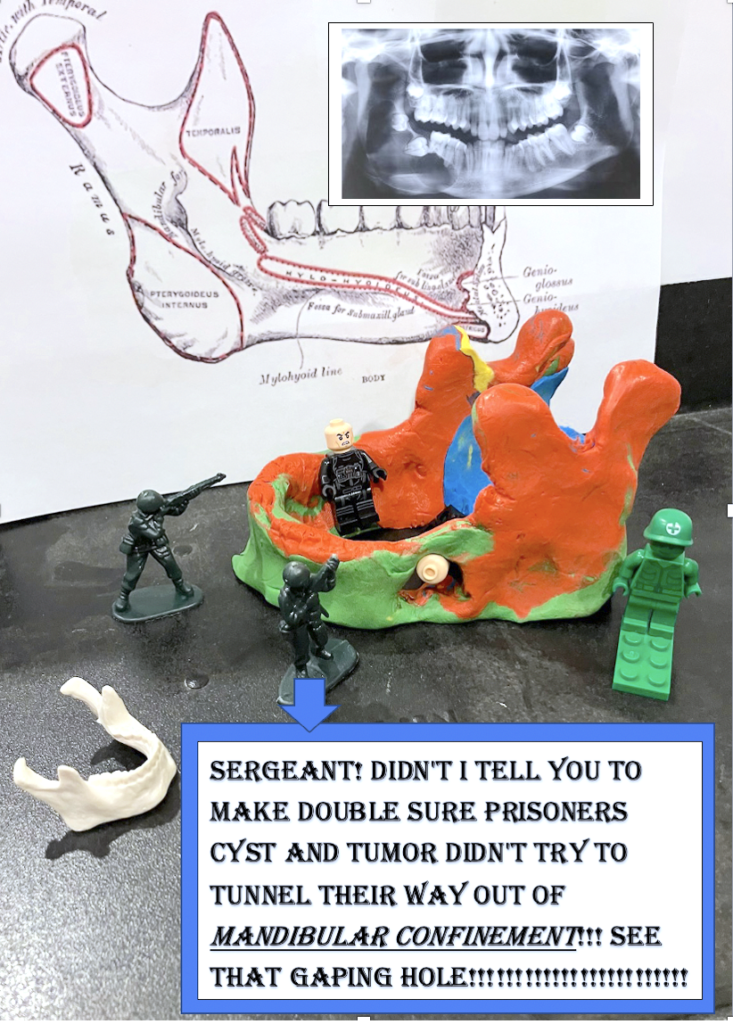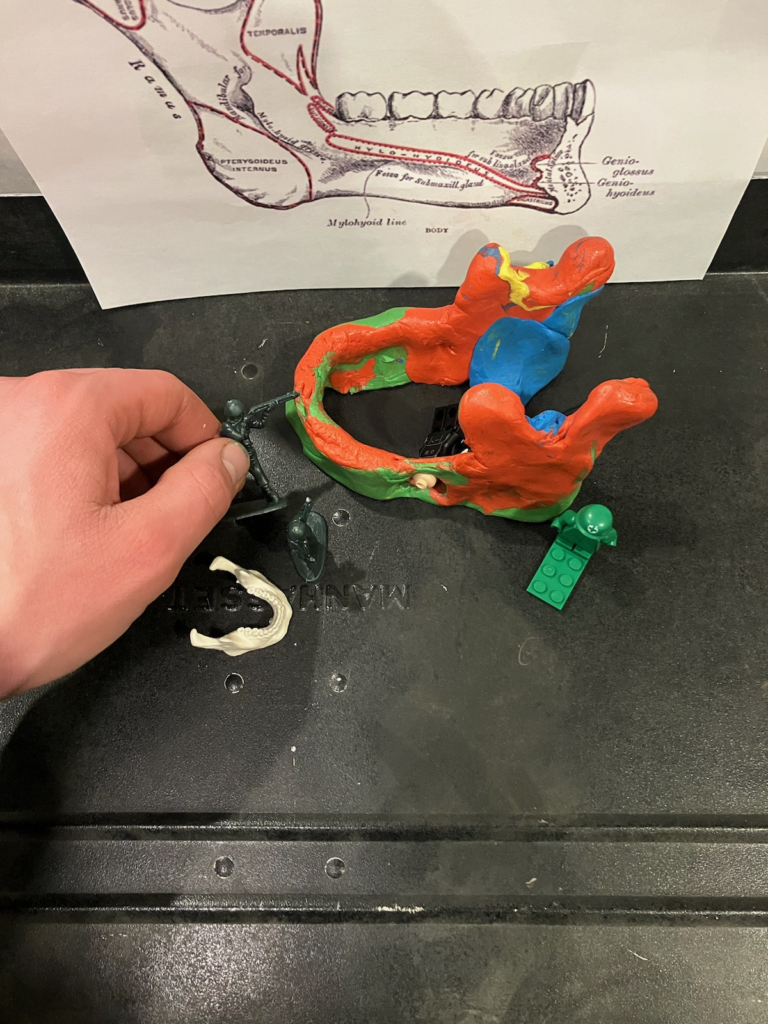
This paper relates more or less to multiple course objectives. They include the following: Describe in depth each type of epithelial and connective tissue, Know the stages of bone development and repair, Know the locations of the bones listed, Identify the key components and various structures of the nervous system.
My artwork is a comic scene of sorts. It shows two small lego men being “held prisoner” inside of a clay representation of a mandible. The prisoners are Mr. Tumor and Mr. Cyst. One of them can be seen attempting to crawl out of a hole on the lower left side of the mandible. The “tunnel” that he has made to “escape” through is located in a region of the jawbone that is quite often affected by bone eating cysts and tumors. Thankfully, he has just been caught by the green army men of the Oral Health Prisoner of War Division, and a medic is now on standby to repair the damage. Both above the scene and in the background there is a diagram of a mandible (Wikipedia, 2024) and an x-ray picture of a jaw bone that has had much of its lower right side become victim to a particularly nasty variety of tumor (Chaudhary, Z., et al., 2024).
There are a staggering variety of cysts and tumors that can affect the jaw. This can make it difficult to distinguish between one or another with electronic imaging, so surgery is often necessary to obtain a specific diagnosis (Vale DS, et al., 2023). Many of them appear on x-rays as what is called a unilocular radiolucency. This means that the x-ray shows a lone spot which is slightly lighter than other regions of bone. Some varieties have clearly define edges and others do not. Sometimes an odd border is all that is shown by an x-ray or related imaging process, as the shade of the afflicted area is the same as the healthy regions. Jaw tumors and cysts eat away at bone so much that they can cause structural failure to occur. Frighteningly, they can affect large areas without ever causing pain (Chaudhary, Z, et al., 2024). Patients often find out about their condition coincidentally. I had one myself once, and I did not know that anything was wrong until my orthodontist happened to notice it in an x-ray that he took during my first appointment with him. A case subject in one of the papers that I found in my research had his discovered in the same way (Vale DS, et al., 2023).
This is the sort of affliction that can be hard to define neatly because there can be many sub-varieties of a given tumor or cyst. For example, one kind of cyst/tumor (I have seen it described as both in my research) is the ameloblastoma. According to the Mayo Clinic, it is tumor, usually benign, that “begins in cells that form the protective enamel lining the teeth.” It attacks and spreads into the jaw bone and is common in the “jaw near molars” (2022). The root word of ameloblastoma is obviously ameloblast. According to one paper, ameloblasts are “epithelially-derived cells” that create tooth enamel (He, P, et al., 2010). Merriam-Webster defines ameloblasts as “one of a group of columnar epithelial cells that produce and deposit enamel on the surface of a developing vertebrate tooth.” Another entry by Merriam-Webster defines an ameloblastoma as a “a tumor of the jaw derived from remnants of the embryonic rudiment of tooth enamel.” This sounds straight forward enough. However, now consider that according to a report published in the International Journal of Surgical Pathology the World Health Organization stated in 1992 that there were three separate kinds of tumors with that name. They were the ameloblastic fibroma, the ameloblastic fibro-odontoma, and the ameloblastic fibrodentinoma. Classifications have since changed, but this certainly shows the error in assuming simplicity exists amongst the different varieties of jaw effecting tumors (Ávila, et al., 2023). A report published by the Journal of Plastic, Reconstructive, and Aesthetic Surgery reported yet another kind of ameloblastoma (at least, it was a new name). This is the unicystic ameloblastoma, and the report provides three subcategories for this particular variant. They are the luminal, intraluminal, and mural. The unicystic ameloblastoma can be ravaging. Some patients with unicystic ameloblastoma have had to have whole sections of their mandibles removed due to the size of the tumor/cyst. Replacing the bone can be a combination of metal implants and grafts. Sometimes the grafts come from the anterior iliac crest of the pubic bone. Other times they come from the ribs. Grafts taken from the ribs are called costochondral grafts (Chaudhary, Z, et al., 2024).
One variety of cyst (also called a lesion) is the solitary bone cyst. It is very often found in the mandible, although it can affect other regions as well. Thankfully, SBC does not have any subclassifications that I can find. True to the pattern, however, it has a variety of names such as hemorrhagic cyst, simple bone cyst, traumatic cyst, and idiopathic bone cavity. According to one case study, “The variety of these names to describe a single lesion reflects the poor understanding of its etiopathogenesis” (Delarue, M., et al., 2024). Simply put, there are so many names because medical professionals are still not sure what causes this specific cyst. However, another source states that a previous trauma to the affected region is widely thought to be the cause (Vale DS, et al., 2023).
Unlike other cysts, the caverns that are formed in the bone by SBC’s do not have a lining of epithelial tissues (examples would be squamous, cuboidal, or columnar cells). In the case study presented by one article, the fact that no epithelium was found alleviated the need for any kind of lab work. It allowed the physician to immediately diagnose the ailment as an SBC. According to the article, “the lesion had no capsule, and surgically it was only an empty cavity” (Vale DS, et al., 2023). An SBC can be full of fluid, fibrous connective tissue, or gas. It is also possible to find combinations of these components. Treatment involves emptying the material that is in the cavern, if there is any. Then the surgeon curettes the bone all along the inside of the cavern. This means that he scrapes it in order to stimulate bleeding and the formation of a blood clot in the cavity. Once a blood clot has filled the empty space in the bone, the surgeon sews the patient back up. The formation of the blood clot allows the bone to begin rebuilding itself. It is possible for the bone to reform fully within six months of the surgery, but the patient must come in for check ups up to a few years after the operation. This is to ensure that the bone has healed and that there is no recurrence of the lesion (Delarue, M., et al., 2024).
Recurrence is a very real possibility when dealing with jaw cysts and tumors. This is especially true if the surgeon is not able to remove all of the tumor. In my case, some of my tumor (an ameloblastoma, I do not know which variety) had to be left in my jaw. Understand that the tumor had engulfed my lower right wisdom tooth which is located in my mandible. Unfortunately, this is directly above the inferior alveolar nerve (Delarue, M., et al., 2024). My surgeon was concerned that he would damage the nerve if he attempted to remove all of the invasive tissue. I had to come back for multiple follow up appointments in the months and even the first one or two years after my surgery to ensure that the bone had healed and that there was no recurrence.
Jaw cysts and tumors constitute a broad field of study. Some other varieties not mentioned in this article specifically are odontogenic myxomas, odontomas, central giant cell granulomas, dentigerous cysts, odontogenic keratocysts, and squamous odontogenic tumors. Unfortunately, there are even more kinds of jaw tumors and cysts than just these (Mayo Clinic, 2022). The good news is that there are skilled oral surgeons who are able to treat them, often making the patient as good as new when the damage is not too extensive.
References
Ávila, G. A., N., Camisasca, D. R., de Barros, L. A. P., & Henriques, Á. C. G. (2023). Ameloblastic Fibrodentinoma and Ameloblastic Fibro-Odontoma: A Developing Odontoma or a Distinct Neoplasm? International Journal of Surgical Pathology, 31(8), 1508–1512. https://doi.org/10.1177/10668969231157778
Chaudhary, Z., Sharma, P., S, H., Joshna, E. K., Garg, V., Augustine, J., Vijayaragavan, R., & Nehra, A. (2024). Unicystic ameloblastoma: Clinico-radiological and histopathological correlation with management. Journal of Plastic, Reconstructive and Aesthetic Surgery, 97, 296–301. https://doi.org/10.1016/j.bjps.2024.07.042
Delarue, M., Perez, C., Lucidarme, Q., & Bornert, F. (2024). Management of a solitary bone cyst using a custom-made surgical guide for a minimally invasive approach: technical note and case report. BMC Oral Health, 24(1). https://doi.org/10.1186/s12903-024-04308-4
He, P., Zhang, Y., Kim, S. O., Radlanski, R. J., Butcher, K., Schneider, R. A., & DenBesten, P. K. (2010). Ameloblast differentiation in the human developing tooth: effects of extracellular matrices. Matrix biology : journal of the International Society for Matrix Biology, 29(5), 411–419. https://doi.org/10.1016/j.matbio.2010.03.001
Mayo Foundation for Medical Education and Research. (2022, January 12). Jaw tumors and cysts. Mayo Clinic. https://www.mayoclinic.org/diseases-conditions/jaw-tumors-cysts/symptoms-causes/syc-20350973
Merriam-Webster. Ameloblast definition. https://www.merriam-webster.com/dictionary/ ameloblast#:~:text=Medical%20Definition-,ameloblast,ameloblastic
Merriam-Webster. Ameloblastoma definition. https://www.merriam-webster.com/dictionary ameloblast#:~:text=Medical%20Definition-,ameloblast,ameloblastic
Vale DS, Helena Bacha LOPES, Gileade Pereira FREITAS, Nilton Pires ARAUJO, Flavia Gabriela ROSA, & Francisco NUNES JÚNIOR. (2023). Atypical traumatic bone cyst involving impacted lower third molar: report of case. RGO: Revista Gaúcha de Odontologia, 71. https://doi.org/10.1590/1981-86372023001120210149
Wikipedia. [Diagram of Mandible: public domain]. (21 November 2024). https://enwikipedia.org/wiki/Mandible#/media/File:Gray177.png
Photograph of me placing the figures.


Ronny’s STEAM project shows how a cyst or tumor can make its way through our mandible, creating a hole in the bone. He does this by making a clay model of a mandible. The cysts and tumors are represented by Lego men, and the army men represent the diagnosis of the cyst or tumor. Along with his model and figures, he has a printed diagram of the mandible and an X-ray of a jaw with a tumor. Ronny explains that there are many different cysts and tumors that can affect a person’s jaw and usually can go undiagnosed until an X-ray is done by a dentist or orthodontist. He also explains the many varieties of cysts and tumors. Giving history about how the names were given and the sub-categories that many of these cysts and tumors have. This can make it difficult to diagnose a cyst or tumor for patients. He explains that surgery is usually needed to correct the hole these cysts or tumors left. With surgery to remove a tumor and if a good portion of the mandible is affected, a bone graft and metal implants are used to repair the damage. With cysts, the surgeon causes the bone to bleed to cause a blood clot, allowing the bone to heal. The recovery from surgery can take a few months and checkups to make sure there is no reoccurrence, as it can happen if all the cysts and tumors are not removed.